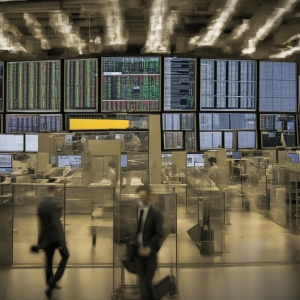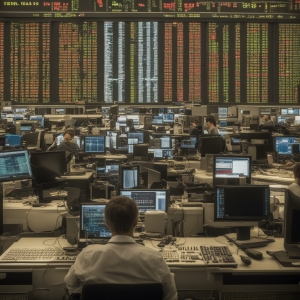In the dynamic world of investing, traditional trading methods are fast giving way to more sophisticated systems. One such system that has been gaining traction among traders is High-Frequency Trading (HFT).
Introduction to High-Frequency Trading
Many of you, who are new to the realms of finance, may ask, what exactly is High-Frequency Trading? Simply put, HFT is a method of trading that uses powerful computers to transact a large number of orders at incredibly fast speeds. These high-speed computers are capable of processing and executing trades in microseconds using algorithmic trading techniques.
The algorithmic models used in HFT are often complex, dealing with many parameters and variables that adjust automatically in real-time. These technologies have given traders the ability to move in and out of positions quickly, exploiting minute price differences and liquidity imbalances to their advantage.
However, just as with any other trading approach, High-Frequency Trading comes with its unique set of risks and rewards, which we'll extensively discuss in subsequent sections. But first, let's delve deeper into this intriguing world of HFT.
Understanding Trading Algorithms
At the heart of High-Frequency Trading lies the magic of trading algorithms. These are the mechanisms that allow HFT to function with such lightning speed. An algorithm is simply a set of instructions or rules that a computer follows to complete a task. In the world of finance, algorithms read and interpret real-time market data, make decisions based on the programmed logic and execute trades.
Trading algorithms are primarily designed to make life easier for traders by automating certain parts of the trading process. They can be used to execute large orders, reduce market impact, or even exploit certain market conditions. In high-frequency trading, they're even more significant – they make split-second decisions based on the live data that wouldn't be possible at human speed.
Trading algorithms in High-Frequency Trading can range from basic ones that execute trades at a specified market price, to complex multi-strategy algorithms. These sophisticated algorithms employ mathematical models to predict market movements and take advantage of even the smallest price discrepancies.
However, these algorithms are only as good as the data they're given and the logic they're programmed with. They lack the ability to think creatively or intuitively and therefore, rely heavily on the strategies based on market rules and historical data.
Pros and Cons of High-Frequency Trading
| Pros | Cons |
|---|---|
| Provides liquidity to the market, making it easier to buy and sell securities. | Can magnify financial losses and volatility in the market. |
| Often results in better bid-ask spreads, benefitting all market participants. | Can be used to manipulate market prices and execute unethical trading strategies. |
| Helps in price discovery by promoting faster dissemination of market information. | May contribute to market instability as it is susceptible to feedback loops and system glitches. |
| Enables market participants to trade on latest news instantly. | May cause issues with market fairness, as HFT firms have advantage over retail investors due to their faster trading capabilities. |
The Role of High-Frequency Trading in Financial Markets

The presence of High-Frequency Trading in the financial world is substantial and impactful. Its role extends beyond just executing trades at high speed. The primary function of HFT is to provide liquidity to the market. Liquidity fuels the smooth operation of financial markets, allowing securities to be bought and sold with minimal delays and price changes. HFTs stand ready to buy and sell securities almost instantly, helping to minimize the spread, which is the difference between the bid and the ask price.
The added liquidity also helps to stabilize markets in times of distress. When markets are volatile, HFTs can step in and provide liquidity, counteracting the imbalances caused by large sell-offs or buy-ins.
While the benefit to the overall functioning of the markets is clear, there's more to high-frequency trading. It also allows for price discovery, helping to ensure that the price of a security accurately reflects supply and demand in the marketplace. Furthermore, High-Frequency Trading has led to a significant reduction in trading costs due to narrower spreads and increased competition among trading firms. However, it's important to note that despite the benefits, HFT isn't without its critics, and the debate about its role and impact on financial markets continues.
Benefits and Risks of High-Frequency Trading
As we delve deeper into the world of High-Frequency Trading, it is vital that we also consider the pros and cons that come along with this type of trading. While HFT provides some distinct advantages, it is not to be overlooked that there are also significant risks involved.
One of the primary benefits of HFT is the increased market efficiency that it brings. Because transactions execute at such a high speed, market discrepancies are quickly taken advantage of, which leads to more efficient pricing. This efficiency makes the market more reflective of the true supply and demand and less subject to manipulation or inflated prices.
High-frequency trading also promotes increased market liquidity. As mentioned earlier, HFTs are always ready to buy and sell securities, which ensures that other investors can complete transactions whenever they want. This higher liquidity levels the playing field for all market players.
However, it is important to note that these benefits come with several risks.
The first and most significant risk of HFT is its potential to cause serious disruptions in the financial market. As trades are executed at such high frequencies, even a minor glitch in an algorithm could result in a significant number of mistaken trades. These massive trade volumes can cause immense volatility in a very short period.
Secondly, High-Frequency Trading can also contribute to a phenomenon known as flash crashes. These are events where the market experiences a very sudden and sharp price drop, followed by an equally sharp recovery. Flash crashes can exacerbate market instability and lead to drastic financial losses. This phenomenon is partly due to the speed and the "herd behavior" of the algorithms used in HFT.
Finally, critics argue that HFT creates an uneven playing field. Even though it is high-speed computers making the trades, it is humans who design and maintain these algorithmic systems. As a result, only those with the financial resources to develop and maintain these complex systems can truly compete in high-frequency trading.
In conclusion, while High-Frequency Trading offers impressive advantages in terms of efficiency and liquidity, it is crucial for market participants to understand and mitigate the potential risks associated with it.
Implications for Regular Traders

For regular traders, the arrival of High-Frequency Trading has been a mixed blessing. While HFT increases market liquidity and aids in more efficient pricing, it also presents some challenges.
The high speed and volume of HFT can lead to increased market volatility. Rapid buying and selling by High-Frequency Trading systems can cause sudden price swings, making it more difficult for human traders to anticipate the market's direction.
Additionally, some critics argue that HFT creates an uneven playing field. High-Frequency Traders have access to ultra-fast technology and sophisticated algorithms that are simply beyond the reach of many regular traders. This disparity in resources has led to concerns about market fairness and transparency.
However, it's not all bad news. The advent of HFT has led to more innovative trading platforms and tools designed to level the playing field. More and more brokers are offering advanced charting tools, automated trading features, and access to real-time market data to help their clients compete.
In conclusion, while High-Frequency Trading has indeed changed the landscape of finance and trading, its effects are manifold. Despite its complications, it is a force that can't be ignored. Thus, it behooves every trader, whether novice or seasoned, to understand it and, where possible, to adapt their strategies to navigate this ever-evolving landscape successfully.
Tips for Navigating High-Frequency Trading
Finally, we'll offer a few tips for those interested in venturing into the world of High-Frequency Trading. While HFT is a complex field reserved primarily for institutional investors, individual investors can still navigate this realm with the right knowledge and tools.
First, it's crucial to remember that HFT is not a strategy but a means to implement various strategies. Consequently, the success of high-frequency trading hinges heavily on the strength of the used trading algorithms. Therefore, developing or choosing a strong, reliable, and effective algorithm is paramount for succeeding in HFT.
Second, understanding the trading environment is vital. As a trader, you need to keep up to date with the latest market trends, regulatory changes, and technological advancements that could deeply impact HFT. Always be aware of the overall market sentiment while paying close attention to emerging market opportunities and potential risks.
Lastly, consider partnering with a reputable trading firm or broker that specializes in HFT. They will have the necessary expertise and resources to guide you through the complexities of high-frequency trading, ensuring that you make informed and calculated trading decisions.
In conclusion, while High-Frequency Trading can be high reward, it can also be high risk. Employing careful and strategic planning combined with disciplined risk management could help mitigate potential pitfalls. As always, continual learning and adapting are key to long-term success in the ever-evolving world of finance and trading.
Conclusion: High-Frequency Trading Explained

In conclusion, High-Frequency Trading can be viewed as an evolution in the financial markets, leveraging the power of cutting-edge technology and complex algorithms. It presents a high-speed, automated approach to trading that contributes to market efficiency and liquidity. However, the lightning-fast operations and reliance on computational power also introduce a new layer of risks into the trading arena.
Regardless, the potential benefits and challenges that HFT poses to the financial markets are undeniable. By understanding the mechanics of High-Frequency Trading and its role in the broader market context, both novice and experienced investors can better navigate this high-speed, technologically advanced segment of the financial world.
Whether High-Frequency Trading is an ally or a foe to the financial markets remains a debated topic. It introduces efficiency and immediacy, yet concurrently opens avenues for market manipulation and risks of abrupt market disruptions. Hence, for those who aspire to delve into HFT, understanding it inside out is the stepping stone to informed investing decisions.
Frequently Asked Questions about High-Frequency Trading
What is High-Frequency Trading?
High-Frequency Trading (HFT) refers to automated trading strategies that are characterized by high-speed trade execution, high turnover rates, and high order-to-trade ratios.
How does High-Frequency Trading work?
HFT employs advanced algorithms and high-speed computers to analyse market data, spot trading opportunities, and execute trades at super-fast speeds, often in a fraction of a second.
What is the purpose of High-Frequency Trading?
The main purpose of HFT is to capitalize on small price differences in financial markets by executing trades quickly and in large quantities.
What are some of the benefits of High-Frequency Trading?
HFT can provide benefits such as increased market liquidity, improved price discovery, and narrower bid-ask spreads.
What are the risks of High-Frequency Trading?
HFT can also contribute to market volatility, disrupt traditional trading practices, and raise questions about market fairness and integrity.







